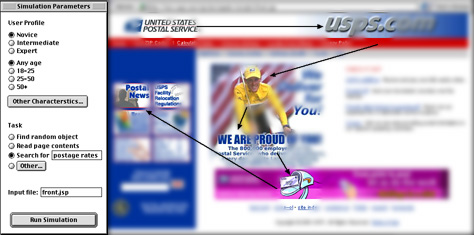

This is an artist's rendition of how a user interface analysis tool might predict a user's visual scan through the U. S. Postal Service home page, and how the tool might convey the hypothesized scan path to the designer. The simulation helps to demonstrate how basic visual structure and simple visual features are always available in the periphery, and how detailed information becomes available during a sequence of eye movements and fixations.
Winter, 2005 - 2 Credits - CRN 23246
Friday, noon-1:20 PM
200 Deschutes
Prof. Hornof's office hours for the term will be Fridays 2-3 PM, or by appointment.
This research seminar will explore the mechanics of building predictive user-interface analysis tools. These tools are software-based assistants used by user interface designers early in the design process to predict the ease of use and the ease of learning of the human-computer interactions that the designer is designing. In this seminar, special emphasis will be placed on (a) predicting performance of visual tasks, such as finding a link on a web page, (b) examining previously constructed tools, and (c) exploring the challenges and solutions in the construction of such tools.
The course is open to all UO grad students who are interested in learning more about the topics listed above. You will be expected attend all ten sessions, read the papers assigned for each class (roughly one journal article per week), provide a thoughtful written response to the assignment posed each week, participate in discussions in an appropriate and constructive manner, and successfully complete an occasional quiz. I will also make an effort to make existing predictive tools available for your use. There may be some relatively straightforward assignments related to using these tools. There should be no programming assignments. Let me know during the first week of class if you will have any difficulty fulfilling these requirements.
We will usually read one or two articles per week. The following is an evolving list of the articles read for each week.
Week 2
Hornof, A. J. (2002). Simulating the Human Visual "Find"
Command. A grant proposal funded by the National Science
Foundation.
Week 3
Hornof, A. J. (2004). Cognitive strategies for the visual search
of hierarchical computer displays. Human-Computer Interaction,
19(3), 183-223.
Week 4
Hornof, A. J., & Halverson, T. (2003). Cognitive strategies
and eye movements for searching hierarchical computer displays.
ACM CHI 2003: Conference on Human Factors in Computing
Systems, New York: ACM, 249-256.
Week 5
Salvucci, D. D. and F. J. Lee (2003). Simple cognitive modeling
in a complex cognitive architecture. Proceedings of ACM CHI 2003:
Conference on Human Factors in Computing Systems, New York:
ACM.
Kieras, D. E. (2001). Using the Keystroke-Level Model to Estimate Execution Times. (Available from David Kieras' web site.)
Week 6
John, B. E., et al. (2004). Predictive human performance modeling
made easy. Proceedings of ACM CHI 2004: Conference on Human
Factors in Computing Systems, New York: ACM.
John, B. E., Konstantine Prevas, et al. (2004). CogTool: Predictive Human Performance Modeling Made Easy - User Guide. Pittsburgh, Pennsylvania: Carnegie Mellon, Human Computer Interaction Institute. (Available at Bonnie John's CogTool website.)
Week 7
Tullis, T. S. (1988). A System for Evaluating Screen Formats:
Research and Application. In R. Hartson & D. Hix (Eds.),
Advances in Human-Computer Interaction. (Vol. 2). Norwood, NJ:
Ablex, 214-286.
Week 8
Ivory, M. Y., R. Sinha, et al. (2001). Empirically validated web
page design metrics. Proceedings of ACM CHI 2001: Conference on
Human Factors in Computing Systems, New York: ACM.
Faraday, P. (2000). Attending to Web Pages. Microsoft Tech. Report.
Week 10
Beymer, D. and D. M. Russell (2005). WebGazeAnalyzer: A System
for Capturing and Analyzing Web Reading Behavior Using Eye Gaze.
IBM Almaden Tech. Report.
Week 5
Identify specific ways in which there would and would not be
benefits (as in, accuracy and ease of modeling) when using ACT-Simple
over KLM.
Week 6
Discuss strengths and weaknesses of the CogTool predictive
modeling tool, as it is discussed on paper and what it is like to use
it.
Week 7
How do you bring DAP up to date, and how do you implement it?
Week 8
Identify a concrete research question based on Tullis, Ivory et
al., and Faraday, or identify a specific eye-tracking study.
John, B., Vera, A., Matessa, M., Freed, M., & Remington, R. (2002). Automating CPM-GOMS. Proceedings of ACM CHI 2002: Conference on Human Factors in Computing Systems, New York: ACM, 147-154.
Tamborello, F., & Byrne, M. (2005) "Information Search: The Intersection of Visual and Semantic Space." Extended Abstracts of ACM CHI 2005 Conference on Human Factors in Computing Systems. download
The above papers have tools associated with them. Here are some additional tools we may look at:
UsableNet (2004). LIFT for Macromedia Dreamweaver. http://www.usablenet.com/products_services/lift_dw/lift_dw.html. This is a Dreamweaver extension that evaluates pages for accessibility.